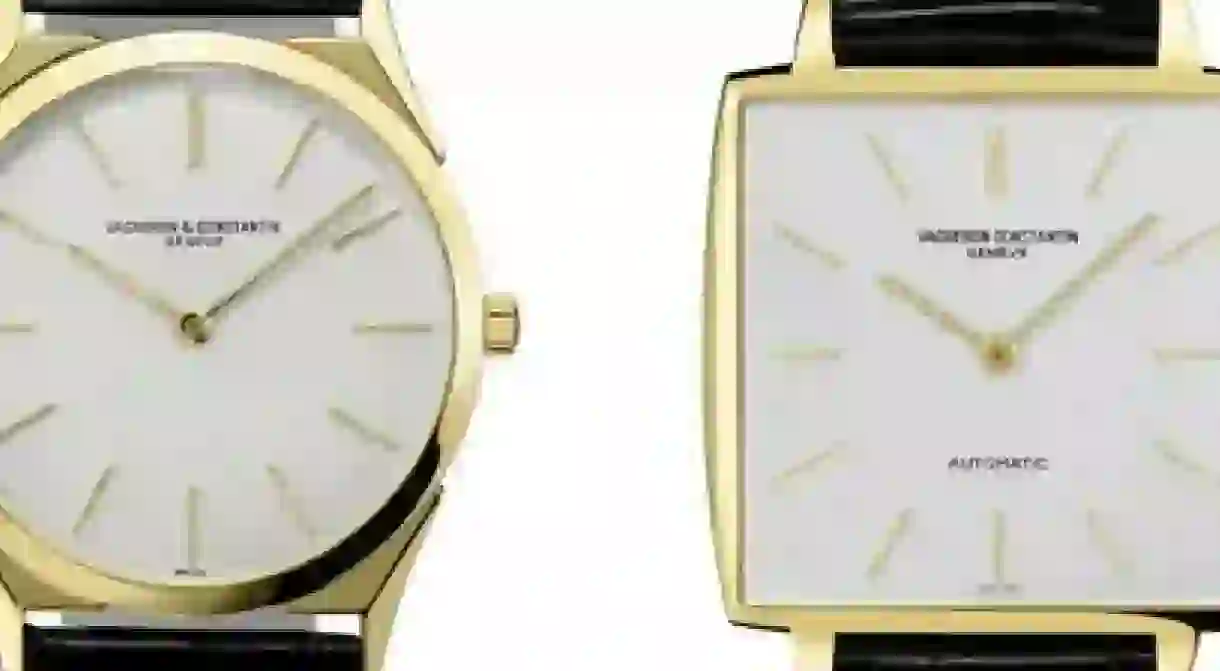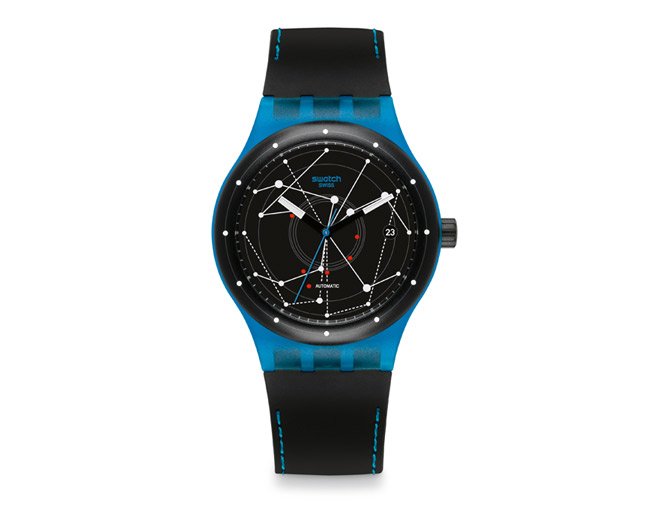The Art of Time: 10 Iconic Swiss Watch Designs

Switzerland is the traditional home of haute horologerie. The world’s best watchmakers established their companies in the spectacular setting of Switzerland’s mountains and have a history of producing incredibly accurate timepieces, as well as intricate, beautiful, luxurious watches. In this article, we look at the ten most iconic watch designs to have come out of Swiss watch companies over the last century.

IWC Portuguese
In the 1930s, two Portuguese businessmen knocked on Swiss IWC watch company’s door. They had a request: to commission a watch so accurate as to stand a comparison with a marine chronometer. Starting from these premises, at IWC the precision of the intricate mechanisms concealed in the watch’s case, rather than its design, was naturally prioritised; and the Portuguese, the model of timepieces born from the challenge set by those businessmen, has a long history of cutting-edge advancements in watch-making. But the Portuguese’s design also turned out to be quite unique: to accommodate the watch’s complex inner workings, the case was made wider than usual (over 40 mm), at a time when smaller was all the rage. The thin bezel and white dial that characterise these watches – along with the leaf hands and embossed Arabic numbers – made it look even bigger. The current vogue and tendency in watch design is towards bigger cases again; and the Portuguese is now revered as a beautiful, classic precursor.

Jaeger-LeCoultre Reverso
Sometimes the simplest ideas are truly the best. One such idea lies at the core of Reverso’s history, a wristwatch first produced in 1931 by Jaeger-LeCoultre. The watch features a case which can be easily slid to the side and swivelled, thus actually hiding the display. For those wondering why anyone would need to do this, the story goes that during a polo game, Swiss businessman and watch collector César de Trey was challenged by one of his opponents to create a watch so resistant that a polo ball couldn’t break it – so Reverso (Latin for ‘I turn around’) was born. Designed as a sports-watch, the Swiss company soon experimented with the watch’s sleek functionality; today, models of the Reverso wristwatches are found with the case’s backside adorned with jewels, decorated with custom engravings, or even showcasing a second display to wear a regular and a fancier watch at the same time. A genius design for a true classic.

Patek Philippe Calatrava
If there is a watch that more than others made the statement that less is more in the history of watch-making, that is Patek Philippe‘s Calatrava. Beautiful and incredibly refined, the Calatrava watches were first introduced in 1932, and were heavily inspired by the then-popular Bauhaus design school which put functionality before aesthetics (a theory effectively summarised in the mantra ‘form follows function’). Several variants are available, but a typical Calatrava is characterised by a round, large case (although not as large as IWC’s Portuguese), plain, white dial, Roman numbers and a thin leather bracelet – but the real proof is in the bezel: be it polished, finely engraved or adorned with diamonds, here is where the sleek, understated elegance of Patek Philippe’s watches reaches its peak. The quintessential simplicity of Calatravas raises these timepieces above trends, making them a timeless choice for those who truly understand beauty.

Rolex Datejust
The Datejust is the most classic watch model ever created by top horologerie Rolex. Introduced in 1945, the Datejust, a self-winding, mechanical chronometer, belongs to the family of Rolex Oyster Perpetual models, the first-ever line of waterproof timepieces, and takes its name from yet another ground-breaking feature it sported: this was the first wristwatch to display the current date in a small window located within the dial. In the following years, the Datejust was further improved with the addition of a Cyclops lens above the date, which magnifies the underlying numbers by two and a half times for greater legibility. The watch is available with either the three-piece link metal Oyster bracelet, or the five-piece link Jubilee bracelet, in steel, gold or a combination of the two. An evergreen, the Datejust remains one of Rolex’s most sought-after models to date.

Omega Speedmaster Professional
In 1965, the NASA tested twelve different watches to measure their resistance to several stress conditions such as extreme temperature, humidity, corrosion, vibrations, noise, and other factors. They were looking for the perfect watch for the astronauts participating in Gemini, one of NASA’s early manned space programmes. Where the watches of Rolex, Longines and TAG Heuer failed, Omega‘s Speedmaster Professional, a model first introduced in 1957, succeeded. Since then, the manual winding chronometer wristwatch has become a legend, and was accordingly nicknamed the ‘Moonwatch’. When he set foot on the Moon, Buzz Aldrin was wearing one (Armstrong’s had been left on the spacecraft). Aside from being incredibly sturdy, Omega Speedmasters are also beautiful objects, with a powerful, masculine design characterised by the signature pitch-black dial and contrasting bright hands.

TAG Heuer Monaco
Before 1969, watch lovers had never seen an automatic chronograph wristwatch with a square case. Then Jack Heuer, Swiss TAG Heuer horologerie’s chairman, came along, and designed the iconic Monaco watch. When first put on the market, Monaco – the name is a tribute to the Monaco Grand Prix, the most prestigious Formula One race – was available in two different models: both had a domed crystal and white numbers and hands, but one had a metallic blue dial, and the other – a metallic gray one. The blue model, however, was always more popular, and remains the most wanted among collectors. In 1971, actor Steve McQueen chose to wear a Monaco watch in his film Le Mans. This instantly propelled Monaco’s success, and kept benefitting the watch’s reputation as McQueen’s popularity grew. The McQueen-Monaco duo is so consolidated that even after the actor’s death, TAG Heuer still uses movie stills as advertising material.

Audemars Piguet
Royal OakRoyal Oak’s debut in 1972 marked a revolution on the watch market: for the first time, a luxury watch had been designed with the use of stainless steel rather than gold. But this was not the only thing that made Audemars Piguet’s Royal Oak a classic. This timepiece is instantly recognisable for its octagonal bezel, screwed onto the case with eight hexagonal, well-visible screws which represent another distinctive feature of the Royal Oaks. Also unique to these watches are the Grande Tapisserie patterns which decorate the dials, a particular type of weaving, geometric – square or lozenge – patterns crafted in Audemars Piguet’s workshops through a complex mechanical process called guillochage. Today, the Royal Oak is available in a variety of colours and materials, but the signature octagonal bezel is consistently maintained across all models of this family.

Historiques Ultra Fine Vacheron Constantin
Can a watch be even simpler than the above-mentioned Patek Philippe’s Calatrava? Yes, it can, and it has been on the market since 1955. It’s Vacheron Constantin‘s Historiques Ultra Fine, a truly stunning piece of haute horologerie. Like Calatravas, the Historiques Ultra Fine watches are extremely simple: the best-known model is characterised by a large, round dial set in a gold case, and a dark leather bracelet. Unique to these timepieces, however, is the case’s extreme thinness: at 1.6 mm thick, this is the world’s thinnest watch with the world’s thinnest mechanical movement, making it an amazing achievement in engineering and technical mastery, in addition to a beautiful object. The Historiques Ultra Fine are also found with a square case, from a line of products launched by Vacheron Constantin in 1968.

Rolex Submariner
If Omega’s Speedmaster Professional was the first watch to land on the moon, the Rolex Submariner made history as the first watch to be water-resistant to 100 metres, positioning itself as the right watch for divers. The Rolex Submariner sports a rugged yet elegant design, with a large round case, a timing bezel, and the Mercedes hour hand, so called because toward the tip it features a three-pointed star that resembles the iconic Mercedes Benz logo, although no connection exists with the car company. Born as a tool watch (i.e. a watch designed especially for a particular purpose, diving in this instance), from the 1960s, with the addition of a date display, the Rolex Submariner was advertised as an everyday watch.

Swatches
Watch collectors might find it insulting for the Swatch timepieces to be mentioned along with the luxury, iconic watches profiled so far, but it can’t be denied that the Swatches changed the history of Swiss watch-making with a bang. Born as a response to an invasion of cheap, plastic watches from Asia that hit the market in the late 1970s, Swatch’s name is an abbreviation of ‘second watch’: after the refined, status symbol, collectible timepiece conceived as a veritable treasure to pass on to future generations, a new watch – a second watch – came along which still came out of Switzerland but was affordable, colourful, and all about the fun. All of a sudden, the watch became a fashion accessory available in hundreds of different models, something to wear at any occasion and yet another way to express one’s personality. Like it or not, the Swatch was a game-changer.
By Graziano Scaldaferri













